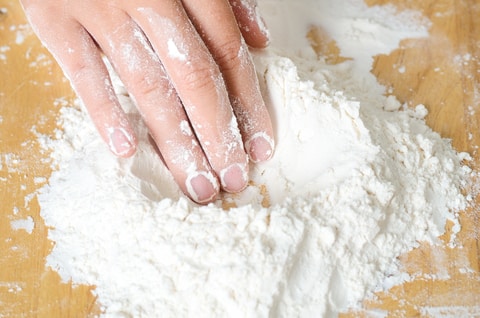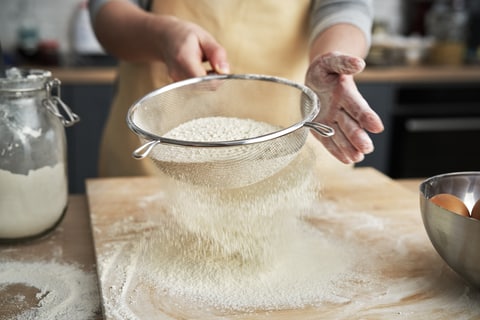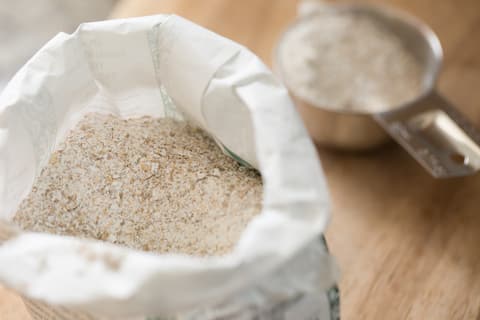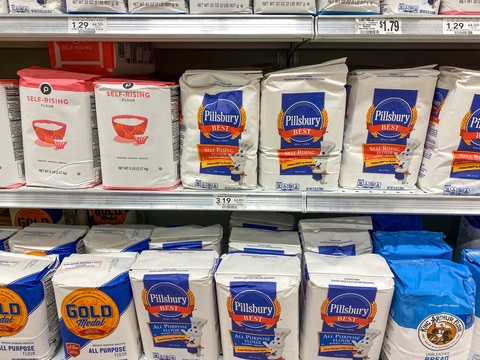
Flour is a major ingredient in countless baked dishes and is almost as widely utilized in other culinary applications.
Whether thickening, soups, stews, curries, and sauces or a core ingredient in batters, bread, biscuits, and more, flour is an inescapable, essential component of so many meals.
At some point, every home cook or baker will encounter a variety of different flours, leading to the question, what is the difference between pre-sifted vs. unsifted flour?
After all, there are pre-sifted and unsifted types of cake and bread flour available, and without knowing the individual characteristics, picking the best option can be confusing.
We are breaking down all the differences and similarities between pre-sifted vs. unsifted flour in our upcoming comparison so that you always know which is the better choice for whatever you may be cooking or baking.
Pre-Sifted Vs. Unsifted Flour Comparison
| Pre-Sifted Flour | Unsifted Flour | |
|---|---|---|
| Definition | Flour Aerated To Smooth Texture By Means Of Mechanical Sifting Before Compressed Packaging | Flour That Hasn't Undergone Any Special Processing Prior To Packaging |
| Volume | Lighter Than Unsifted Flour, 1/4 Quantity Extra Volume | Volume Per Bag/Fill Level Differs, Denser Than Sifted Flour |
| Suitability | Puffy & Soft Confectionary, Batters & Cakes | All-Purpose Suitability |
| Affordability | Higher Price Than Unsifted Flour | Cheaper Than Sifted Flour |
| Availability | Limited Availability | Widespread Availability |
| Considerations | High Mixing Capability, Best Aeration Possible, Manual Sifting Still Recommended | Sifting Needed Before Measuring To Ensure Accurate Density | All Flour Technically Unsifted To A Degree |
Pre Sifted vs Unsifted Flour
Some swear by the one only while others don’t mind which variety they buy. Our comprehensive comparison of pre-sifted vs. unsifted flour covers everything that you need to know to make an informed decision upon your next shopping trip.
Pre-Sifted Flour
Even though there’s only a minor difference in consistency, pre-sifted flour can be a timesaver. Without sifting, it mixes much better than unsifted flour giving it an edge off the bat.
Here’s a breakdown of what pre-sifted flour is, when to use it, and how it differs from unsifted flour.
What Is Pre-Sifted Flour?
Pre-sifted flour is the type of flour that comes in bags or stacks, all sifted and compressed.
It is all-purpose, cake or bread flour that’s been aerated and refined to a silky, smooth texture by means of mechanical sifting before the flour is packed into compressed packages.
Specialized mechanical or pneumatic sifters are used to refine unsifted flour into pre-sifted flour which presents a finer consistency that’s better for baking.
Volume
By default, pre-sifted flour is much lighter than unsifted flour due to its degree of super fineness.
You’ll find that pre-sifted flour has a good density and fluffs to a good volume as the minuscule air gaps between the flour powder particles are removed through the act of sifting.
Many home bakers have noticed that buying pre-sifted flour grants a little extra flour and therefore greater value for money. After sifting pre-sifted flour, one typically ends up with a ¼ of the quantity extra.
This is again why weighing your flour after sifting is so important.
Suitability
Usually, puffy and soft confectionery dishes like cake, pastries, and various batters call for pre-sifted flour, so the flour evenly settles down with other baking ingredients without ever forming lumps or a textured consistency once baked.
Any cakes that need to be as light as possible, like sponge cake, genoise, and angel food cake, all need pre-sifted flour, which is then, preferably, sifted again.
Anyone baking in bulk, such as commercial bakers or caterers, will find great time-saving value from using pre-sifted flour instead of manually sifting each batch.
Affordability
Flour that is sold as pre-sifted will generally come at a slightly higher price point than unsifted flour.
Unless you’re baking massive volumes of goods at a time or run a commercial kitchen, most home cooks don’t find the higher price to be warranted, especially when the cook is someone who plans to sift their flour by hand before use anyway.
Availability
Pre-sifted flour is far less common than unsifted flour. You’ll have to hunt it down specifically, and not all stores stock pre-sifted flour.
It’s readily available online and in stores that specifically supply a larger than normal, all-inclusive baking ingredients department.
Considerations
Pre-sifted flour has a high mixing capability due to its ultra-fine texture. Even though pre-sifted flour is sifted beforehand, meticulous cooks looking for as much aeration as possible in their dough or battle will still want to sift their flour.
From the moment the pre-sifted flour is packaged, it begins to condense, so for the finest results with the best aeration possible, sift all flour by hand before use.
Unsifted Flour
Most types of all-purpose cake and bread flour come unsifted by default. Most bakers agree that all unsifted flour, and actually all flour, some would say, needs to be sifted before baking.
You decide for yourself after going through our breakdown of the defining characteristic of unsifted flour.
What Is Unsifted Flour?
Unsifted flour is regular wheat flour that has not undergone any special processing to refine its consistency. It is the complete opposite of pre-sifted flour and is prone to clumping, especially under humid storage conditions and prolonged storage.
Volume
None of the batches of unsifted flour are definite in the level that they’re filled to due to minuscule weight variations and remain uncompacted.
This is why many recipes call for sifted flour. In order to reach an exact volume, one needs to sift out the flour first.
Suitability
There isn’t much of a difference between pre-sifted flour and unsifted flour other than a minor improvement to pre-sifted flour’s consistency.
Yet, even this slight benefit can be negated depending on the handling of the pre-sifted flour itself. One can safely purchase unsifted flour and then sift it by hand before use.
Due to the ready availability and slightly lower price, unsifted flour is generally the best choice for home cooks and bakers.
Affordability
Unsifted flour is the price that most of us are used to paying for general all-purpose wheat flour or cake flour. Pay close attention to each individual brand of flour as you may end up being in for a pleasant surprise.
Despite being marked simply as “flour,” many leading brands come pre-sifted.
Availability
No matter where you do your grocery shopping, you’ll always find unsifted flour readily available with many brands and varieties typically on offer.
Considerations
Volumetric measures of flour and other powder or grain-like substances are unreliable. The density to which unsifted flour packs down is too variable to use cups or other fixed measurements as reliable measures.
Anyone who values precision while baking will always sift their unsifted flour first and then weigh it before use.
Customers will also find that many reputable brands of all-purpose flour come pre-sifted even though not specifically advertise that they are. As mentioned, sifting all flour before use is best.
What Is The Difference Between Pre-Sifted Vs. Unsifted Flour?
The main difference between pre-sifted and unsifted flour is that pre-sifted flour has been machine-sifted before packaging, which allows it to be condensed more while giving it a smoother, silkier, more pourable consistency, whereas unsifted flour has not undergone any special processing and thus needs to be sifted by hand before use.
How To Measure Pre-Sifted Vs. Unsifted Flour?
Almost all professional bakers will agree that it is far better to sift all flour before use. This being said, whether or not to sift or leave flour unsifted while measuring will be specified by your recipe.
Read the ingredients and method carefully. If the recipe calls for ‘1 Cup Flour, Sifted’, then you should measure out a single cup of unsifted flour and then sift it into the other dry ingredients.
Adversely, when the recipe says ‘1 Cup Sifted Flour,’ you need to sift the flour before dispensing it, sifted, the cup measure.
Which Flour Should You Buy, Pre-Sifted Flour Vs. Unsifted Flour?
The sole purpose of sifting your flour is to make the flour’s quantity much more reliable in terms of volume and density.
So if you buy pre-sifted flour from the market, you never know how much motion and handling each individual pre-sifted bag of flour has undergone.
At the same time, consider that once you pour out pre-sifted flour, you are simultaneously changing its state, making it, at least to a degree, partially unsifted.
We say that commercial bakers and those truly pressed for time, and perhaps those without a sieve, should opt for pre-sifted vs. unsifted flour, which is for everyone else.
There’s simply no good reason to suffer from impure flour contaminated with dirt and other particles while at the same time not benefitting from the aeration and silky smooth consistency of sifted flour.









